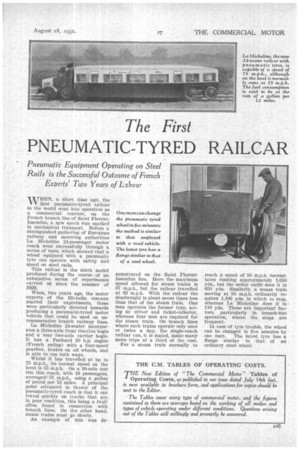The First
Page 57

If you've noticed an error in this article please click here to report it so we can fix it.
PNEUMATIC-TYRED RAILCAR
Pneumatic Equipment Operating on Steel Rails is the Successful Outcome of French Experts' Two Years of Labour
WHEN, a short time ago, the first pneurnatic-tyred railcar in the world went into operation as a commercial venture, on the French branch line of Saint FlorentIssoudnn, a new epoch was marked in mechanical transport. Before a distinguished gathering of European railway and motoring authorities La Micheline 24-passenger motor coack went successfully through a series of tests, which showed that a wheel equipped with a pneumatic tyre can operate with safety and speed on steel rails.
This railcar is the ninth model produced during the course of an exhaustive series of experiments carried on since the summer of 1929.
When, two years ago, the motor experts of the Michelin concern started their experiments, these were particularly directed towards producing a pneumatic-tyred motor vehicle that could be used on unremunerative branch railway lines. La Micheline 24-seater incorporates a three-axle front tractive bogie and a rear two-axle carrier bogie. It has a Panhard 20 h.p. engine (French rating) with a four-speed gearbox, brakes on all wheels, and is able to run both ways.
Whilst it has travelled at up to 75 m.p.h., its normal speed on the level is 55 m.p.h. On a 30-mile test run this coach, with 18 passengers, average& 57 m.p.h., using a gallon of petrol per 12 miles. A principal point advanced in favour of the pneumatic-tyred coach is that it can travel quickly on tracks that are. in poor condition, this being a fault often found in connection with branch lines. On the other hand, steam trains must go slowly.
An example of this was de monstrated on the Saint FlorentIssoudun line. Here the maximum speed allowed for steam trains is 37 m.p.h., but the railcar travelled at 62 m.p.h. With the railcar the deadweight is about seven times less than that of the steam train. One man operates the former type, acting as driver and ticket-collector, whereas four men are required for the steam train. On branch lines where such trains operate only once or twice a day, The single-coach railcar can, it is stated, make many more trips at a third of the cost
For a steam train normally to reach a speed of 50 m.p.h. necessitates running approximately 1,650 yds., but the motor outfit does it in 650 yds. Similarly, a steam train moving at 50 m.p.h. ordinarily requires 1,100 yds. in which to stop, whereas La Micheline does it in 110 yds. These are important factors, particularly in branch-line operation, where the stops are frequent.
In case of tyre trouble, the wheel can be changed in five minutes by one man. The latest tyre has a flange similar to that of an ordinary steel wheel.




























































































